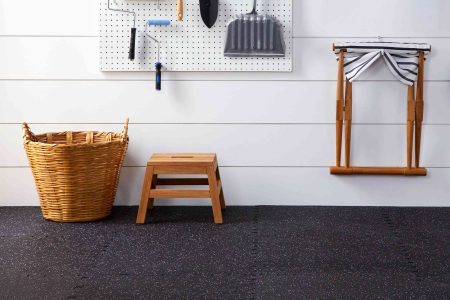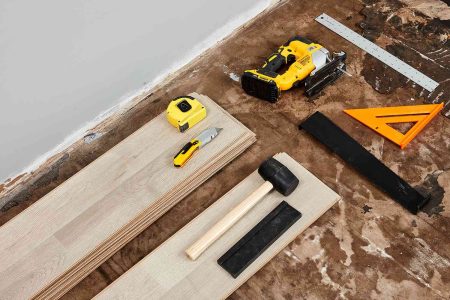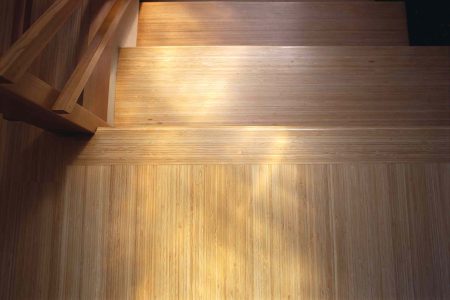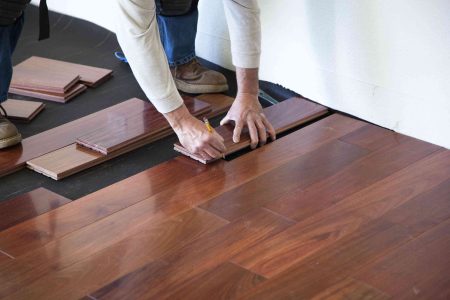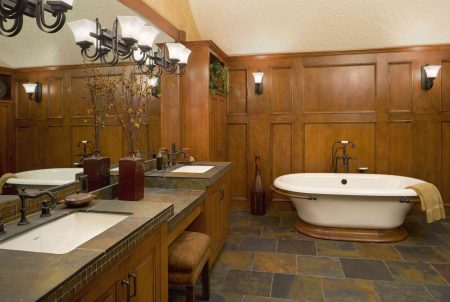Although a home’s floor is usually thought to be simply the surface layer of a visible floor covering, a floor is a system of layered components, each of which is essential to the function and durability of the floor. And one of the more crucial layers is one that is rarely seen—the underlayment.
Flooring underlayment is found just under the surface floor covering, and it helps add to the stability, comfort, and soundproofing abilities of the floor covering.
What Flooring Underlayment Is
Flooring underlayment is either a hard or soft material that is installed under the floor covering and above the subfloor. Flooring underlayment equalizes imperfections in the subfloor, softens and cushions the floor covering to make the floor easier to walk on, protects against moisture, and provides some sound insulation. Foam, cork, and rubber are common soft underlayments. Hard underlayment materials include plywood and hardboard.
Where Underlayment Fits in a Floor Structure
Most floors in residential homes consist of four layers. Starting at the top and working downward, these layers are:
- Floor covering: Floor covering is the finished, visible flooring surface, such as hardwood planks, carpeting, ceramic tile, or vinyl. Floor covering is the layer that you see and walk on.
- Underlayment: Just under the visible floor covering is a layer of material, usually only about 1/4- or 1/2-inch thick, and this is the underlayment. The purpose of underlayment is to provide a smooth, flat surface for the floor covering. It can be made of many different materials, chosen depending on the needs of the floor covering. Plywood, hardboard, and cement board are common choices, but often the underlayment is simply a thin foam padding.
- Subfloor: This layer of OSB or plywood is part of the home’s construction and will already be in place when the underlayment and floor covering is installed. These panels of OSB or plywood are integral to the structure of the home and provide strength and rigidity to the floor system when attached to the floor joists. The OSB or plywood is normally 19/32- to 1 1/8-inch thick.
- Joists: These lateral wooden framing members rest on foundation walls and beams and provide structural support for the entire framing system. Joists are typically made from 2-by-10 or 2-by-12 lumber or engineered microlam members.
Click Play to Learn the Difference Between Subfloor, Underlayment, and Joists
Benefits of Flooring Underlayment
Flooring underlayment is a thin material that rests between the floor covering above and the subfloor below. Because underlayment is a catchall term, it can take different forms depending on the flooring material is supports.
Unlike the subfloor, which is part of a home’s framework and structure, the underlayment serves mostly to provide a flat smooth surface to allow for easy, attractive installation of the surface flooring. It may also serve additional functions, such as deadening the sound of footsteps, softening the feeling of the flooring underfoot, and in some cases acting as a moisture barrier. The primary purposes of underlayment are:
- Smooths the surface: Underlayment provides a smoother and more predictable surface for the floor covering than the subfloor, which serves a mostly structural role.
- Improves adhesion: In the case of cement board, this underlayment provides a good surface for ceramic tile to bond to. Tile does not adhere well when applied directly to a subfloor, which is known to expand and contract.
- Improves structural stability: As a residual effect, a hard underlayment can give the entire floor better stability. It is particularly useful in this function in older homes, where the subfloor may be constructed with boards rather than OSB or plywood sheets.
Soft Underlayments
Foam and cork underlayments do two things. First, they provide a very slight buffer between the top floor covering and imperfections in the underlying subfloor (or the existing floor, if you are installing new flooring directly over the old). Foam and cork underlayments can smooth out imperfections, such as barely protruding screw heads and small knot holes.
Loose, soft underlayments do not provide the same kind of structure as sheets of wood or cement board, so they are floating underlayments. This means that they are not attached to the subfloor at all.
Depending on the situation, these materials usually should not be used as a replacement for a rigid underlayment applied directly over a subfloor. But they can be a good solution when you are installing a new floor covering directly over an old floor that is still in good shape.
For example, a layer of foam or cork can work well as an underlayment when you are installing laminate flooring over an existing wood or ceramic tile floor. And a layer of foam or cork laid over a rigid underlayment can be an effective sound-deading cushion that will make laminate flooring sound and feel less hollow underfoot.
Rigid Flooring Underlayments
Many floor coverings are best installed over a rigid underlayment applied over the subfloor. Plywood and hardboard such as luan are common rigid underlayments. Subfloor panels such as DRIcore, cement board, and OSB stretch the definition of underlayment, but are sometimes thought of in this context.
- Plywood: Sheets of 4-by-8-foot A/C grade plywood cut to size are an excellent underlayment. A/C refers to plywood that has one relatively smooth face and one relatively rough side (for the bottom). It depends on your situation, but 1/4- to 1/2-inch thick AC grade plywood tends to be the best flooring underlayment for many dry applications (under the hardwood, laminate, and engineered wood). The A-graded side is smooth enough even for the thinnest vinyl flooring. Shiplap or tongue-and-groove plywood sheets are available to use for underlayment, but straight-edge sheets are perfectly acceptable.
- Underlayment panels: Underlayment panels are interlocking and come in 2-by-2-foot tiles. DRIcore is one well-known brand of underlayment panels. Fairly expensive, they make the installation go much faster and are great as a moisture barrier. They are an ideal underlayment if you are installing carpeting or laminate flooring on a concrete slab since they lift the flooring slightly off the concrete.
- Cement board: Cement board sheets such as Wonderboard, or fiber-cement-board sheets such as Durock, are sometimes used only for mortared flooring, such as stone and porcelain or ceramic tile. Cement board is smooth, easy to cut, and mold-resistant.
- OSB: Orient-strand board may be used as an underlayment for some floor coverings, but plywood is generally preferred for any flooring where a hard underlayment is recommended.
When Underlayment Is Not Necessary
Flooring underlayment of some type is usually required with most floor coverings. But there are some instances where underlayment is not required and it may even be harmful to the floor system.
Pre-Attached Laminate Underlayment
A prime example of when additional underlayment isn’t needed is when the underlayment is already attached to the bottom of the floor covering. With laminate flooring, the trend is now for the underlayment to come pre-attached. Not only is underlayment not needed, but laying down another layer of underlayment would contribute to the floor’s instability. Laminate flooring manufacturers typically state that loose underlayment should not be used with pre-attached underlayment.
New Construction
In new, well-built construction, the subfloor may be so sturdy and smooth that carpeting can be laid directly on a carpet padding attached directly to the subfloor, or hardwood flooring can be installed on a simple layer of rosin paper spread over the new subfloor.
Old Floor Covering as Underlayment
It is also possible that the previous floor covering might adequately serve as your underlayment. For example, it is common for laminate flooring to be laid directly on existing sheet vinyl. And new luxury vinyl can often be laid over old vinyl without problems.
Carpeting is often laid over existing hard floors with no underlayment at all, other than the carpet padding. Consult the instructions for your new flooring material for advice on what kind of underlayment is adequate.
Rebuilt Subflooring
More often though, and almost always in remodeling projects, a more substantial underlayment will need to be attached over the subfloor to compensate for deficiencies. In cases where the subfloor is in very bad shape, it’s even possible that the subfloor itself will need to be removed and a new subfloor layer installed before underlayment and floor covering can be installed.
In a bathroom that has seen water damage, for example, the old plywood or OSB subfloor may need to be removed down to the joists, a new subfloor laid, followed by a cement board underlayment, and finally new ceramic tile floor covering.
Special Considerations
Keep your underlayment as thin as possible. Thicker underlayments will begin to pose problems since they can create offset issues between rooms with different flooring materials. Transitions can be problematic if the floor level is substantially higher in one room than in the adjacent room. And in rooms with low ceilings, thick underlayments may even pose a problem by shortening the height of the space.
Also consider how a thick or thin underlayment may affect doors and trim sizes: They may need to be cut to stay level. In kitchens, be aware that a thicker floor covering will affect the opening height from the top of the floor to the underside of the countertop, which could make appliance removal and replacement more difficult.
Read the full article here




